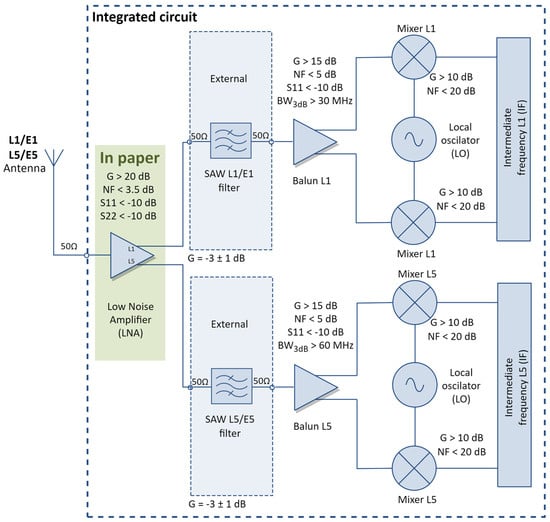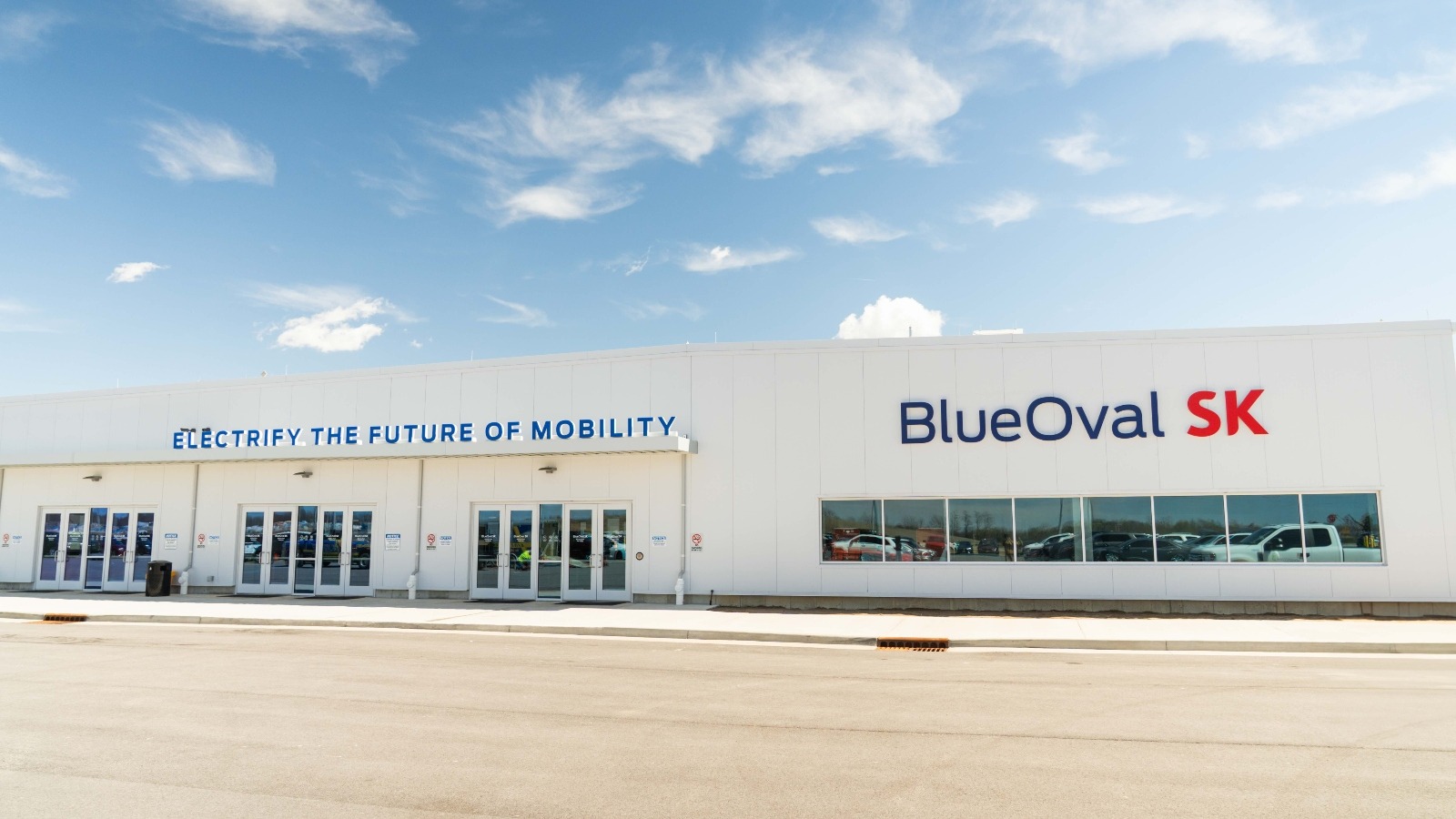1. Introduction
The proposed dual-band low-noise amplifier solution is different from other solutions in that it provides the amplification of two bands, L1 and L5, allowing the use of only one shared inductor for input impedance and noise matching. This saves a significant amount of area because, at frequencies associated with the L1 and L5 bands, the inductance of the inductor can be significant, e.g., from 8 to 20 nH, which involves an area of 300 µm × 300 µm or even up to 450 µm × 450 µm. Another advantage of using a single radio-frequency input for both amplified bands is the possibility of using a dual-band antenna—this involves further space savings and fewer external components.
The main drawback of the circuit is that it is non-trivial to achieve good impedance matching and noise matching at its input for both bands—as in a classic low-noise amplifier circuit. The circuit can be used in all types of multi-frequency radio transceiver systems and is probably one of the best solutions for such applications.
2. Design Considerations
The main task of the low-noise amplifier is to amplify the input signal. A high amplifier gain allows the total noise figure of the system to be reduced. Since it defines the lower limit of the total noise figure of the receiver circuit, it should provide the lowest possible noise figure. A low-noise amplifier should have good impedance matching at the input and output, good noise matching, sufficient gain linearity (IIP2, IIP3) and low current consumption.
The key parameters that characterize the LNA circuit are the voltage gain (G), noise figure (NF), input impedance matching (S11), output impedance matching (S22), isolation between output and input (S12), current consumption and the size of the device.
The inductance Ls allows the real part of the input impedance to be controlled without adding noise. The Lgg coil determines a specific resonant frequency and is also responsible for noise matching. The Ld coil increases the gain of the amplifier and acts as a band-pass filter when combined with the capacitive load. The use of a cascode allows good isolation between the output and input to be achieved and minimizes the capacitive Miller effect. The capacitor Cin is used to cut off the DC component. Additionally, the Cex capacitor makes simultaneous impedance and noise matching easier while maintaining low power consumption.
Based on the solution presented above, we proposed a dual-band low-noise amplifier that saves the silicon area and allows the use of a single dual-band antenna.
3. Circuit Design
The Lgg coil is mainly responsible for noise matching and is responsible for establishing the appropriate resonant frequency at which the amplifier operates. Unfortunately, adjusting the amplifier with a single inductor on two bands is not trivial. Assuming that the center frequencies of the L1 and L5 bands are 1.575 GHz and 1.192 GHz, respectively, the average frequency of these two values is about 1.4 GHz. At this resonant frequency, the value of inductance Lgg will be pre-selected. It is necessary to assume the values of the currents polarizing the amplifying transistors M1 and M5—for example, 5 mA. The next key step is to properly select the size of the M1 and M5 transistors to obtain the best noise matching for each of the amplifier bands. The next step is to select the appropriate value of the Ls1 and Ls5 inductances to obtain a good impedance match. The Ls1 and Ls5 inductances are selected separately to obtain the best match for a given band (Ls1 = 0.82 nH, quality factor Q = 3.7 and Ls5 = 0.83 nH, quality factor Q = 2.98). In impedance matching, they play the main role in matching to the real part of the signal source impedance (matching to 50 Ω). By obtaining good results in terms of noise and impedance matching at the amplifier input, it is possible to check the effect of changing the Lgg inductance on the noise figure. With well-sized transistors and similar noise figures for both bands, changing the Lgg value will make it possible to obtain a better noise figure for one band while degrading the noise figure of the other band. If we have similar noise figures for each band and varying the Lgg value causes the described changes, this is the point at which the minimum obtainable noise figure at a given bias current has been achieved.
If we wish for the noise figure for both bands to be the same, its value will be higher than the analogous noise figure for a single-band low-noise amplifier. This research shows that a dual-band low-noise amplifier will have a higher noise figure for each band by about 0.4–0.6 dB. This is the cost of a two-band low-noise amplifier solution with one coil shared by both bands.
In the case of integrated LNA circuits, two different solutions for the use of inductors are commonly used. The first solution is to use externally mounted inductors on PCBs and the second is to use integrated inductors created in the process of manufacturing the integrated circuit. The main difference between these inductors is the quality factor.
The inductor mounted on the PCB is characterized by a Q factor that is over 10 times better than that of the integrated inductor. The high quality factor of the Lgg input inductor allows for much better noise matching (obtaining lower NF)—an inductor with a high inductance value has low resistance. In the case of using high-quality inductors in the drain Ld and source Ls of the amplifier, thanks to their lower resistance at the same inductance value, we are able to achieve a greater gain (there is no voltage drop in the inductor resistance). An inductor with a higher quality factor in the drain also affects the shape of the amplifier’s bandwidth—the amplifier becomes more narrowband. The main disadvantage of these inductors is that they require additional external components, which generates significant costs in mass production.
4. Results
4.1. Simulation Environment
4.2. Simulation Results
To sum up the simulation results, the designed dual-band low-noise amplifier is characterized by good parameters in both the dual-band and single-band modes. Thanks to the ability to work in the single-band mode, the system gains the ability to save energy when needed.
4.3. Measurements
The designed low-noise amplifier may be powered by 1.5 V in two ways. The first way is to power the LNA from an external LDO located on the PCB. This provides an output voltage of 1.5 V, which is fed to the LNA’s VDD11_RFO power rail. The second option is to supply the LNA from an internal LDO (externally supplied with 1.8 V VDD18RF), giving an output voltage of 1.5 V to the LNA supply rail. Measurements show that the choice of power source for a dual-band low-noise amplifier has no effect on its performance. Simulations and measurements were performed using the internal LDO as the LNA power source.
- Keithley 6512 electrometer—to measure the current consumption (up to 20 mA), used as an ammeter. The current consumption was measured using an external LDO with the ammeter connected in series (jumper J18, Figure 12).
- EXA Signal Analyzer N9010A and external noise source (SNS)—the output of the noise source (Figure 15 port P1) was fed to the input of the low-noise amplifier (RF_IN); the output of the low-noise amplifier (LNA_OUT1) was connected to the input of the signal analyzer (Figure 15 port P1) for the L1 band.
5. Conclusions
The proposed dual-band low-noise amplifier is characterized by a high gain for both the L1 and L5 bands and a noise factor sufficient for navigation applications. One of its advantages is that it is well matched to 50 ohms at the input and output, which allows it to be easily integrated with other systems operating with an impedance of 50 ohms, e.g., antennas and filters. Another advantage is the possibility of turning off one band, e.g., when it is not needed, in order to save energy. This is very important for devices operating on batteries.
The measured parameters of the LNA at 1.575 GHz (L1 band center frequency) in the dual-band mode were voltage gain (GV) = 21.22 dB, S11 = −23.89 dB, S22 = −12.65 dB, S12 = −32.53, NF = 3.23 dB, current consumption (IDD) = 6.13 mA.
The measured parameters of the LNA at 1.192 GHz (L5 band center frequency) in the dual-band mode were voltage gain (GV) = 18.2 dB, S11 = −8.42 dB, S22 = −15.8 dB, S12 = −28.29 dB, NF = 3.53 dB, current consumption (IDD) = 6.13 mA.
The measured parameters of the LNA at 1.575 GHz (L1 band center frequency) in the single L1 band mode were voltage gain (GV) = 20.41 dB, S11 = −23.57 dB, S22 = −12.8 dB, S12 = −32.57, NF = 3.44 dB, current consumption (IDD) = 2.85 mA.
The measured parameters of the LNA at 1.192 GHz (L5 band center frequency) in the single L5 band mode were voltage gain (GV) = 18.16 dB, S11 = −6.9 dB, S22 = −16.3 dB, S12 = −27.79 dB, NF = 3.27 dB, current consumption (IDD) = 3.48 mA.
The designed system meets the specifications.
Source link
Daniel Pietron www.mdpi.com


